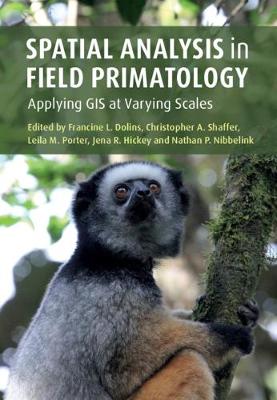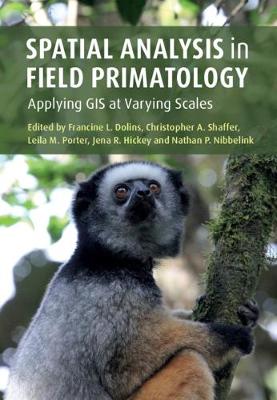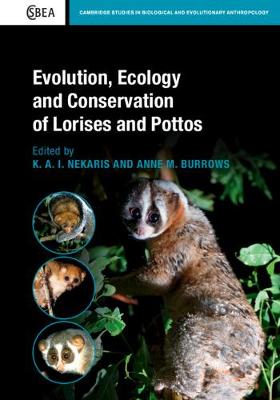Spatial Analysis in Field Primatology
 -10%
portes grátis
-10%
portes grátis
Spatial Analysis in Field Primatology
Applying GIS at Varying Scales
Dolins, Francine L.; Porter, Leila M.; Hickey, Jena R.; Shaffer, Christopher A.; Nibbelink, Nathan P.
Cambridge University Press
02/2021
460
Dura
Inglês
9781107062306
15 a 20 dias
1080
Descrição não disponível.
Part I. GPS for Primatologists: Introduction Leila M. Porter; 1. Why place matters, and its use in primate behavioral and ecological research Francine L. Dolins; 2. Fundamentals of GPS AND GIS Nathan P. Nibbelink and Joanna Hatt; 3. 'Next-gen' tracking in primatology: opportunities and challenges Margaret C. Crofoot; 4. The ethical implications, and practical consequences, of attaching remote telemetry apparatus to macaques Amy Klegarth, Agustin Fuentes, Lisa Jones-Engel, Greg Marshall and Kyler Abernathy; 5. Processing geospatial data in R: a primer Allison Howard and Roger Mundry; 6. Estimating travel distance and linearity of primate routes: ideas on how to clean and smooth track data collected with a handheld GPS Karline R. L. Janmaat, Simone D. Ban and Roger Mundry; Part II. GIS Analysis in Fine-Scale Space: Introduction Christopher A. Shaffer; 7. Home range analysis: why the methods matter Sarah A. Boyle; 8. Quantifying resource dispersion in free-ranging bearded sakis in Guyana: what is a patch? Christopher A. Shaffer; 9. Interpreting small-scale patterns of ranging by primates: what does it mean, and why does it matter? Mitchell T. Irwin and Jean-Luc Raharison; 10. Determining the presence of habitual travel route networks in orangutans (pongo pygmaeus morio) in Kutai National Park, Borneo Adam O. Bebko; 11. Finding fruit in a tropical rainforest: a comparison of the foraging patterns of two distinct fruit-eating primates across years Leila M. Porter, Paul Garber, Christopher Boesch and Karline R. L. Janmaat; 12. Random walk analyses in primates Amy L. Schreier and Matt Grove; 13. The use of small-scale spatial analysis to evaluate primate behavior and welfare in captive settings Stephen R. Ross and Marisa A. Shender; 14. The promise of spatially explicit agent-based models for primatology research Anthony Di Fiore; Part III. GIS Analysis in Broad-Scale Space: Introduction Francine L. Dolins; 15. Modeling niches and mapping distributions: progress and promise of ecological niche models for primate research Kenneth L. Chiou and Mary E. Blair; 16. Does reduced habitat quality or increased hunter access explain defaunation of fragmented forests? Bonobos as a case study Jena R. Hickey and Michael J. Conroy; 17. Landscape ecology of deforestation processes and lemur biogeography in Madagascar Travis S. Steffens and Shawn M. Lehman; 18. Quantitative methods for primate biogeography and macroecology Jason M. Kamilar and Lydia Beaudrot; 19. GIS and GPS techniques in an ethnoprimatological investigation of St Kitts green monkey (chlorocebus sabaeus) crop-foraging behavior Kerry M. Dore, Daniel Sewell, Eduardo M. Mattenet and Trudy R. Turner; 20. Conclusion Francine L. Dolins.
Este título pertence ao(s) assunto(s) indicados(s). Para ver outros títulos clique no assunto desejado.
Part I. GPS for Primatologists: Introduction Leila M. Porter; 1. Why place matters, and its use in primate behavioral and ecological research Francine L. Dolins; 2. Fundamentals of GPS AND GIS Nathan P. Nibbelink and Joanna Hatt; 3. 'Next-gen' tracking in primatology: opportunities and challenges Margaret C. Crofoot; 4. The ethical implications, and practical consequences, of attaching remote telemetry apparatus to macaques Amy Klegarth, Agustin Fuentes, Lisa Jones-Engel, Greg Marshall and Kyler Abernathy; 5. Processing geospatial data in R: a primer Allison Howard and Roger Mundry; 6. Estimating travel distance and linearity of primate routes: ideas on how to clean and smooth track data collected with a handheld GPS Karline R. L. Janmaat, Simone D. Ban and Roger Mundry; Part II. GIS Analysis in Fine-Scale Space: Introduction Christopher A. Shaffer; 7. Home range analysis: why the methods matter Sarah A. Boyle; 8. Quantifying resource dispersion in free-ranging bearded sakis in Guyana: what is a patch? Christopher A. Shaffer; 9. Interpreting small-scale patterns of ranging by primates: what does it mean, and why does it matter? Mitchell T. Irwin and Jean-Luc Raharison; 10. Determining the presence of habitual travel route networks in orangutans (pongo pygmaeus morio) in Kutai National Park, Borneo Adam O. Bebko; 11. Finding fruit in a tropical rainforest: a comparison of the foraging patterns of two distinct fruit-eating primates across years Leila M. Porter, Paul Garber, Christopher Boesch and Karline R. L. Janmaat; 12. Random walk analyses in primates Amy L. Schreier and Matt Grove; 13. The use of small-scale spatial analysis to evaluate primate behavior and welfare in captive settings Stephen R. Ross and Marisa A. Shender; 14. The promise of spatially explicit agent-based models for primatology research Anthony Di Fiore; Part III. GIS Analysis in Broad-Scale Space: Introduction Francine L. Dolins; 15. Modeling niches and mapping distributions: progress and promise of ecological niche models for primate research Kenneth L. Chiou and Mary E. Blair; 16. Does reduced habitat quality or increased hunter access explain defaunation of fragmented forests? Bonobos as a case study Jena R. Hickey and Michael J. Conroy; 17. Landscape ecology of deforestation processes and lemur biogeography in Madagascar Travis S. Steffens and Shawn M. Lehman; 18. Quantitative methods for primate biogeography and macroecology Jason M. Kamilar and Lydia Beaudrot; 19. GIS and GPS techniques in an ethnoprimatological investigation of St Kitts green monkey (chlorocebus sabaeus) crop-foraging behavior Kerry M. Dore, Daniel Sewell, Eduardo M. Mattenet and Trudy R. Turner; 20. Conclusion Francine L. Dolins.
Este título pertence ao(s) assunto(s) indicados(s). Para ver outros títulos clique no assunto desejado.







